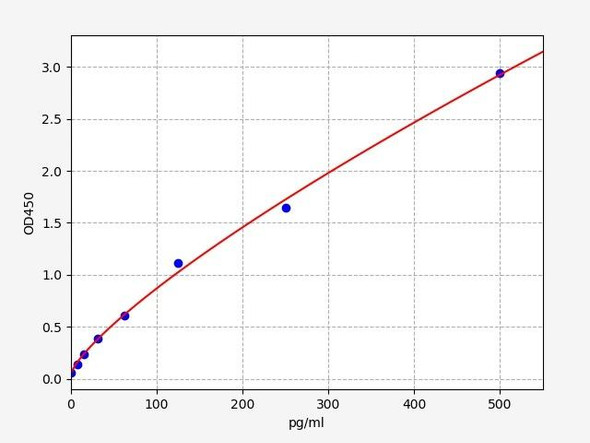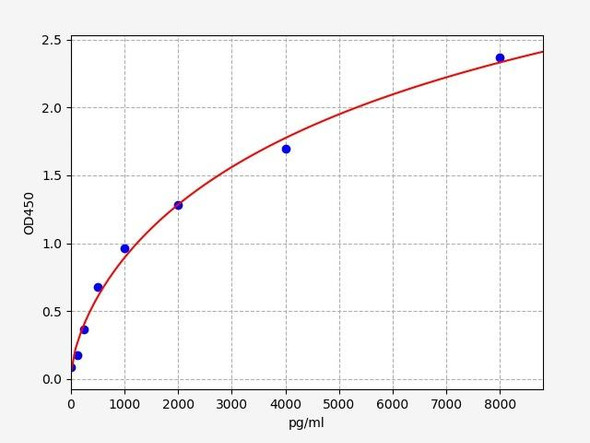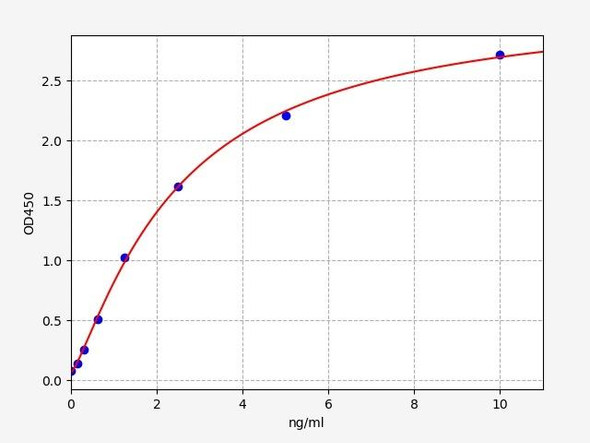HIF-1 alpha ELISA Kit
- SKU:
- HUFI00398
- Product Type:
- ELISA Kit
- Size:
- 96 Assays
- Uniprot:
- Q16665
- Sensitivity:
- 0.094ng/ml
- Range:
- 0.156-10ng/ml
- ELISA Type:
- Sandwich
- Synonyms:
- HIF-1alpha, HIF1A, ARNT-interacting protein, Basic-helix-loop-helix-PAS protein MOP1, BHLHE78, Class E basic helix-loop-helix protein 78, HIF-1-alpha, HIF1-alpha, hypoxia-inducible factor 1-alpha, Member of PAS protein 1, member of PAS superfamily 1,
- Reactivity:
- Human
Description
HIF-1 alpha ELISA
HIF1A (Hypoxia Inducible Factor 1 Subunit Alpha) is a protein that is expressed in response to low oxygen levels. It has been shown to play a role in tumorigenesis and metastasis. HIF1A is involved in the process of angiogenesis, which is the formation of new blood vessels. HIF1A also plays a role in the regulation of energy metabolism. Diseases associated with HIF1A include Hypoxia and Retinal Ischemia. Among its related pathways are Signaling by PTK6 and CDK-mediated phosphorylation and removal of Cdc6.
| Product Name: | HIF-1 alpha ELISA Kit |
| Product Code: | HUFI00398 |
| Size: | 96 Assays |
| Alias: | HIF-1alpha, HIF1A, ARNT-interacting protein, Basic-helix-loop-helix-PAS protein MOP1, BHLHE78, Class E basic helix-loop-helix protein 78, HIF-1-alpha, HIF1-alpha, hypoxia-inducible factor 1-alpha, Member of PAS protein 1, member of PAS superfamily 1, PAS domain-containing protein 8 |
| Detection method: | Sandwich ELISA, Double Antibody |
| Application: | This immunoassay kit allows for the in vitro quantitative determination of Human HIF1A concentrations in serum plasma and other biological fluids. |
| Sensitivity: | 0.094ng/ml |
| Range: | 0.156-10ng/ml |
| Storage: | 4°C for 6 months |
| Note: | For Research Use Only |
| Recovery: | Matrices listed below were spiked with certain level of Human HIF1A and the recovery rates were calculated by comparing the measured value to the expected amount of Human HIF1A in samples. |
| |
| Linearity: | The linearity of the kit was assayed by testing samples spiked with appropriate concentration of Human HIF1A and their serial dilutions. The results were demonstrated by the percentage of calculated concentration to the expected. |
| |
| CV(%): | Intra-Assay: CV<8% Inter-Assay: CV<10% |
| Component | Quantity | Storage |
| ELISA Microplate (Dismountable) | 8×12 strips | 4°C for 6 months |
| Lyophilized Standard | 2 | 4°C/-20°C |
| Sample/Standard Dilution Buffer | 20ml | 4°C |
| Biotin-labeled Antibody(Concentrated) | 120ul | 4°C (Protect from light) |
| Antibody Dilution Buffer | 10ml | 4°C |
| HRP-Streptavidin Conjugate(SABC) | 120ul | 4°C (Protect from light) |
| SABC Dilution Buffer | 10ml | 4°C |
| TMB Substrate | 10ml | 4°C (Protect from light) |
| Stop Solution | 10ml | 4°C |
| Wash Buffer(25X) | 30ml | 4°C |
| Plate Sealer | 5 | - |
Other materials and equipment required:
- Microplate reader with 450 nm wavelength filter
- Multichannel Pipette, Pipette, microcentrifuge tubes and disposable pipette tips
- Incubator
- Deionized or distilled water
- Absorbent paper
- Buffer resevoir
| Uniprot | Q16665 |
| UniProt Protein Function: | HIF1A: a master transcriptional regulator of the adaptive response to hypoxia. Under hypoxic conditions, activates the transcription of over 40 genes, including erythropoietin, glucose transporters, glycolytic enzymes, vascular endothelial growth factor, HILPDA, and other genes whose protein products increase oxygen delivery or facilitate metabolic adaptation to hypoxia. Plays an essential role in embryonic vascularization, tumor angiogenesis and pathophysiology of ischemic disease. Binds to core DNA sequence 5'-[AG]CGTG-3' within the hypoxia response element (HRE) of target gene promoters. Activation requires recruitment of transcriptional coactivators such as CREBPB and EP300. Activity is enhanced by interaction with both, NCOA1 or NCOA2. Interaction with redox regulatory protein APEX seems to activate CTAD and potentiates activation by NCOA1 and CREBBP. Involved in the axonal distribution and transport of mitochondria in neurons during hypoxia. Interacts with the HIF1A beta/ARNT subunit; heterodimerization is required for DNA binding. Interacts with COPS5; the interaction increases the transcriptional activity of HIF1A through increased stability. Interacts with EP300 (via TAZ-type 1 domains); the interaction is stimulated in response to hypoxia and inhibited by CITED2. Interacts with CREBBP (via TAZ-type 1 domains). Interacts with NCOA1, NCOA2, APEX and HSP90. Interacts (hydroxylated within the ODD domain) with VHLL (via beta domain); the interaction, leads to polyubiquitination and subsequent HIF1A proteasomal degradation. During hypoxia, sumoylated HIF1A also binds VHL; the interaction promotes the ubiquitination of HIF1A. Interacts with SENP1; the interaction desumoylates HIF1A resulting in stabilization and activation of transcription. Interacts (Via the ODD domain) with ARD1A; the interaction appears not to acetylate HIF1A nor have any affect on protein stability, during hypoxia. Interacts with RWDD3; the interaction enhances HIF1A sumoylation. Interacts with TSGA10. Interacts with RORA (via the DNA binding domain); the interaction enhances HIF1A transcription under hypoxia through increasing protein stability. Interaction with PSMA7 inhibits the transactivation activity of HIF1A under both normoxic and hypoxia- mimicking conditions. Interacts with USP20. Interacts with RACK1; promotes HIF1A ubiquitination and proteasome- mediated degradation. Interacts (via N-terminus) with USP19. Under reduced oxygen tension. Induced also by various receptor-mediated factors such as growth factors, cytokines, and circulatory factors such as PDGF, EGF, FGF2, IGF2, TGFB1, HGF, TNF, IL1B, angiotensin-2 and thrombin. However, this induction is less intense than that stimulated by hypoxia. Repressed by HIPK2 and LIMD1. Expressed in most tissues with highest levels in kidney and heart. Overexpressed in the majority of common human cancers and their metastases, due to the presence of intratumoral hypoxia and as a result of mutations in genes encoding oncoproteins and tumor suppressors. 2 isoforms of the human protein are produced by alternative splicing. |
| UniProt Protein Details: | Protein type:Autophagy; DNA-binding; Transcription factor Chromosomal Location of Human Ortholog: 14q23.2 Cellular Component: nucleoplasm; transcription factor complex; cytoplasm; nucleolus; nuclear speck; cytosol; nucleus Molecular Function:RNA polymerase II transcription factor activity, enhancer binding; histone deacetylase binding; Hsp90 protein binding; transcription factor binding; protein kinase binding; histone acetyltransferase binding; protein binding; signal transducer activity; enzyme binding; protein heterodimerization activity; sequence-specific DNA binding; ubiquitin protein ligase binding; transcription factor activity; nuclear hormone receptor binding Biological Process: lactation; oxygen homeostasis; embryonic placenta development; response to muscle activity; cellular iron ion homeostasis; positive regulation of transcription, DNA-dependent; glucose homeostasis; signal transduction; positive regulation of vascular endothelial growth factor receptor signaling pathway; muscle maintenance; negative regulation of bone mineralization; connective tissue replacement during inflammatory response; elastin metabolic process; axon transport of mitochondrion; regulation of transcription, DNA-dependent; visual learning; heart looping; angiogenesis; regulation of transcription from RNA polymerase II promoter in response to oxidative stress; neural crest cell migration; negative regulation of growth; hemoglobin biosynthetic process; positive regulation of neuroblast proliferation; negative regulation of TOR signaling pathway; regulation of transforming growth factor-beta2 production; Notch signaling pathway; collagen metabolic process; embryonic hemopoiesis; positive regulation of nitric-oxide synthase activity; positive regulation of erythrocyte differentiation; B-1 B cell homeostasis; digestive tract morphogenesis; mRNA transcription from RNA polymerase II promoter; positive regulation of chemokine production; positive regulation of angiogenesis; neural fold elevation formation; regulation of gene expression; positive regulation of hormone biosynthetic process; cartilage development; positive regulation of glycolysis; lactate metabolic process; response to hypoxia; epithelial to mesenchymal transition; positive regulation of transcription from RNA polymerase II promoter; positive regulation of endothelial cell proliferation; cerebral cortex development |
| NCBI Summary: | This gene encodes the alpha subunit of transcription factor hypoxia-inducible factor-1 (HIF-1), which is a heterodimer composed of an alpha and a beta subunit. HIF-1 functions as a master regulator of cellular and systemic homeostatic response to hypoxia by activating transcription of many genes, including those involved in energy metabolism, angiogenesis, apoptosis, and other genes whose protein products increase oxygen delivery or facilitate metabolic adaptation to hypoxia. HIF-1 thus plays an essential role in embryonic vascularization, tumor angiogenesis and pathophysiology of ischemic disease. Alternatively spliced transcript variants encoding different isoforms have been identified for this gene. [provided by RefSeq, Jul 2011] |
| UniProt Code: | Q16665 |
| NCBI GenInfo Identifier: | 2498017 |
| NCBI Gene ID: | 3091 |
| NCBI Accession: | Q16665.1 |
| UniProt Secondary Accession: | Q16665,Q53XP6, Q96PT9, Q9UPB1, C0LZJ3, |
| UniProt Related Accession: | Q16665 |
| Molecular Weight: | 95,634 Da |
| NCBI Full Name: | Hypoxia-inducible factor 1-alpha |
| NCBI Synonym Full Names: | hypoxia inducible factor 1, alpha subunit (basic helix-loop-helix transcription factor) |
| NCBI Official Symbol: | HIF1A |
| NCBI Official Synonym Symbols: | HIF1; MOP1; PASD8; HIF-1A; bHLHe78; HIF-1alpha; HIF1-ALPHA |
| NCBI Protein Information: | hypoxia-inducible factor 1-alpha; ARNT interacting protein; ARNT-interacting protein; HIF-1-alpha; PAS domain-containing protein 8; basic-helix-loop-helix-PAS protein MOP1; class E basic helix-loop-helix protein 78; hypoxia-inducible factor 1 alpha isoform I.3; hypoxia-inducible factor 1, alpha subunit (basic helix-loop-helix transcription factor); hypoxia-inducible factor1alpha; member of PAS protein 1; member of PAS superfamily 1 |
| UniProt Protein Name: | Hypoxia-inducible factor 1-alpha |
| UniProt Synonym Protein Names: | ARNT-interacting protein; Basic-helix-loop-helix-PAS protein MOP1; Class E basic helix-loop-helix protein 78; bHLHe78; Member of PAS protein 1; PAS domain-containing protein 8 |
| Protein Family: | Hypoxia-inducible factor |
| UniProt Gene Name: | HIF1A |
| UniProt Entry Name: | HIF1A_HUMAN |
*Note: Protocols are specific to each batch/lot. For the correct instructions please follow the protocol included in your kit.
Before adding to wells, equilibrate the SABC working solution and TMB substrate for at least 30 min at 37°C. When diluting samples and reagents, they must be mixed completely and evenly. It is recommended to plot a standard curve for each test.
| Step | Protocol |
| 1. | Set standard, test sample and control (zero) wells on the pre-coated plate respectively, and then, record their positions. It is recommended to measure each standard and sample in duplicate. Wash plate 2 times before adding standard, sample and control (zero) wells! |
| 2. | Aliquot 0.1ml standard solutions into the standard wells. |
| 3. | Add 0.1 ml of Sample / Standard dilution buffer into the control (zero) well. |
| 4. | Add 0.1 ml of properly diluted sample ( Human serum, plasma, tissue homogenates and other biological fluids.) into test sample wells. |
| 5. | Seal the plate with a cover and incubate at 37 °C for 90 min. |
| 6. | Remove the cover and discard the plate content, clap the plate on the absorbent filter papers or other absorbent material. Do NOT let the wells completely dry at any time. Wash plate X2. |
| 7. | Add 0.1 ml of Biotin- detection antibody working solution into the above wells (standard, test sample & zero wells). Add the solution at the bottom of each well without touching the side wall. |
| 8. | Seal the plate with a cover and incubate at 37°C for 60 min. |
| 9. | Remove the cover, and wash plate 3 times with Wash buffer. Let wash buffer rest in wells for 1 min between each wash. |
| 10. | Add 0.1 ml of SABC working solution into each well, cover the plate and incubate at 37°C for 30 min. |
| 11. | Remove the cover and wash plate 5 times with Wash buffer, and each time let the wash buffer stay in the wells for 1-2 min. |
| 12. | Add 90 µl of TMB substrate into each well, cover the plate and incubate at 37°C in dark within 10-20 min. (Note: This incubation time is for reference use only, the optimal time should be determined by end user.) And the shades of blue can be seen in the first 3-4 wells (with most concentrated standard solutions), the other wells show no obvious color. |
| 13. | Add 50 µl of Stop solution into each well and mix thoroughly. The color changes into yellow immediately. |
| 14. | Read the O.D. absorbance at 450 nm in a microplate reader immediately after adding the stop solution. |
When carrying out an ELISA assay it is important to prepare your samples in order to achieve the best possible results. Below we have a list of procedures for the preparation of samples for different sample types.
| Sample Type | Protocol |
| Serum | If using serum separator tubes, allow samples to clot for 30 minutes at room temperature. Centrifuge for 10 minutes at 1,000x g. Collect the serum fraction and assay promptly or aliquot and store the samples at -80°C. Avoid multiple freeze-thaw cycles. If serum separator tubes are not being used, allow samples to clot overnight at 2-8°C. Centrifuge for 10 minutes at 1,000x g. Remove serum and assay promptly or aliquot and store the samples at -80°C. Avoid multiple freeze-thaw cycles. |
| Plasma | Collect plasma using EDTA or heparin as an anticoagulant. Centrifuge samples at 4°C for 15 mins at 1000 × g within 30 mins of collection. Collect the plasma fraction and assay promptly or aliquot and store the samples at -80°C. Avoid multiple freeze-thaw cycles. Note: Over haemolysed samples are not suitable for use with this kit. |
| Urine & Cerebrospinal Fluid | Collect the urine (mid-stream) in a sterile container, centrifuge for 20 mins at 2000-3000 rpm. Remove supernatant and assay immediately. If any precipitation is detected, repeat the centrifugation step. A similar protocol can be used for cerebrospinal fluid. |
| Cell culture supernatant | Collect the cell culture media by pipette, followed by centrifugation at 4°C for 20 mins at 1500 rpm. Collect the clear supernatant and assay immediately. |
| Cell lysates | Solubilize cells in lysis buffer and allow to sit on ice for 30 minutes. Centrifuge tubes at 14,000 x g for 5 minutes to remove insoluble material. Aliquot the supernatant into a new tube and discard the remaining whole cell extract. Quantify total protein concentration using a total protein assay. Assay immediately or aliquot and store at ≤ -20 °C. |
| Tissue homogenates | The preparation of tissue homogenates will vary depending upon tissue type. Rinse tissue with 1X PBS to remove excess blood & homogenize in 20ml of 1X PBS (including protease inhibitors) and store overnight at ≤ -20°C. Two freeze-thaw cycles are required to break the cell membranes. To further disrupt the cell membranes you can sonicate the samples. Centrifuge homogenates for 5 mins at 5000xg. Remove the supernatant and assay immediately or aliquot and store at -20°C or -80°C. |
| Tissue lysates | Rinse tissue with PBS, cut into 1-2 mm pieces, and homogenize with a tissue homogenizer in PBS. Add an equal volume of RIPA buffer containing protease inhibitors and lyse tissues at room temperature for 30 minutes with gentle agitation. Centrifuge to remove debris. Quantify total protein concentration using a total protein assay. Assay immediately or aliquot and store at ≤ -20 °C. |
| Breast Milk | Collect milk samples and centrifuge at 10,000 x g for 60 min at 4°C. Aliquot the supernatant and assay. For long term use, store samples at -80°C. Minimize freeze/thaw cycles. |
Fill out our quote form below and a dedicated member of staff will get back to you within one working day!






